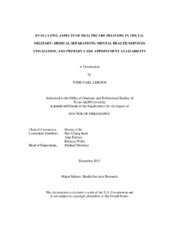| dc.description.abstract | This dissertation examines how access to care is changing in today’s military and how these changes impact various populations. Three topics are examined, which cover pre-existing personality disorder discharges, mental health services utilization of military families, and appointment availability within the medical home.
First, U.S. military discharges and pre-existing personality disorders are examined in a health policy analysis. The Department of Defense (DoD) is facing allegations that servicemembers were wrongfully discharged for pre-existing personality disorders. From 2001 to 2007, 26,000 enlisted servicemembers were discharged for a pre-existing personality disorder (2.6% of total discharges). A government review found the DoD did not adhere to discharge protocols. This analysis explores personality disorders discharges in the military, analyzes various costs to stakeholders, and identifies policy alternatives.
Next is an analysis of mental health services utilization among family members of active duty servicemembers. Much attention has focused on the importance of mental health with military servicemembers. A far less studied topic is the mental health of military families. This study analyzed the mental health services utilization of military family members between 2011 and 2014. A negative binomial generalized estimating equation was used to examine the rate of change in mental health services utilization against various deployment phases. Associations emerged between deployment phases (i.e., deployment 1, between deployments, deployment 2) with increases in mental health services utilization ranging between 12% and 20%. For military children, there was a notable decrease (~ 9%) in mental health services utilization for the pre-deployment phase only.
The final analysis examines the rate of change in appointment availability as U.S. Navy primary care clinics transition to the medical home. Recent implementation of the Patient-Centered Medical Home (PCMH) in U.S. Navy primary care clinics has gained significant traction and attention from leadership and policy makers. The PCMH is a healthcare model encompassing comprehensive care, patient-centeredness, and coordinated care. One area not addressed by prior research is how appointment availability changes over time as clinics certify as medical homes. A retrospective, longitudinal analysis of 21 primary care clinics from 2011 to 2014 was performed to examine changes in appointment availability. Results include pre-certification rates that were statistically different from post-certification rates. Furthermore, the fixed effect rate of time (post-certification) was statistically significant (p-value 0.011). The change in appointment availability is suggestive of increased access for patients, but the practical difference is likely negligible given the small coefficient estimate. | en |


